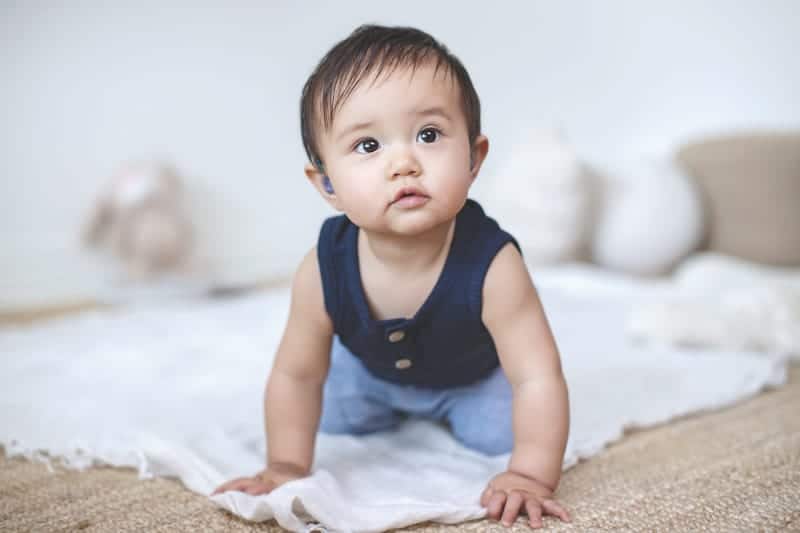A look at the latest advancements in pediatric hearing aids and practical advice to enhance the fitting experience for younger audiology patients and the HCPs who treat them.
By Christine Russo-Mayer, AuD
We all know the crucial role that hearing instruments play in improving the quality of life for children with hearing loss. However, technology alone without professional intervention is never enough for our pediatric patients (after all, it is rarely enough for our adult patients). Ultimately, successfully navigating pediatric hearing aid fittings requires a combination of the right technology with exceptional patient care. This article covers the latest advancements in pediatric hearing aids and provides insights and practical advice for audiologists who support these young patients and their families.
Advancements in Pediatric Hearing Aid Technology
Feature-rich Pediatric Hearing Aids
Pediatric hearing aids have come a long way in recent years, with innovations that benefit both children and parents. The most popular pediatric hearing aids offer feature-rich devices that incorporate adaptive noise reduction, universal wireless connectivity, rechargeable options, and compatibility with adaptive Roger (DM) devices for education. Some hearing aids like the new Phonak Sky Lumity series even claim to provide improved speech understanding in child-specific environments, such as classrooms.
Customization for Kids
Children are not just little adults. That’s why it is essential that manufacturers continue to tailor pediatric hearing aids to the unique needs of children from the ground up rather than simply taking an adult hearing aid and tweaking it to make a pediatric version. Pediatric hearing aids must be versatile to allow for tamperproof ear hooks and battery doors, as well as activation of LED indicator lights to help parents monitor hearing aid status. There also needs to be the ability to make precise, child-specific adjustments. For example, prioritizing speech understanding in noise is key. This customization not only ensures optimal hearing and comfort, but also maximizes the effectiveness of the device in helping children engage with their surroundings.
Teleaudiology/Remote Fitting Support
The advent of teleaudiology has opened new possibilities in the field of audiology. With tools like remote fitting and virtual follow-ups, pediatric audiologists can enhance both the convenience and accessibility of care for both parents and children. I’m personally a big fan of the myPhonak Jr. app. In addition to providing all the benefits of remote support, it also lets parents view wear time and make volume adjustments. Apps like this give children a sense of ownership and accountability in their treatment plan, which is vital for long-term compliance and best outcomes.
AI’s Role in Pediatric Hearing Care
AI is popping up everywhere these days, but today’s pediatric hearing aids have been incorporating elements of AI like machine learning for years. Machine learning is technically a subset of AI, but to me, the difference lies in whether the device can make real-time decisions that truly mimic human behavior. As mentioned, pediatric patients have unique needs. So, when it comes to AI, children’s hearing aids must be trained differently, too.
Hearing aids with machine learning can automatically switch to appropriate programs based on the acoustics of the child’s environments. This alleviates the need for parents and older children and teens to actively figure out which program will provide optimal benefit. Equally important, the AI must allow the hearing aids to continuously learn and improve decision-making over time.
Wireless Connectivity for Educational Enrichment
All modern pediatric hearing aids offer wireless connectivity to external devices like smartphones and tablets. This feature extends beyond convenience; it can significantly contribute to a child’s educational enrichment—for example, enabling children to stream audio directly from educational apps, videos, and learning resources. This integration promotes active participation in lessons, ensures that children do not miss valuable information, and fosters a sense of inclusivity in educational settings.
Rechargeable Options for Convenience
Rechargeable hearing aids have become increasingly popular in pediatric audiology. These devices eliminate the need for disposable batteries, which can be challenging for parents to manage. All parents and many of today’s older kids already own and know how to recharge various devices, so rechargeable hearing aids should be a natural fit for them. Besides, a fully charged set of hearing aids every morning simplifies the daily routine, eliminates concerns about infants and young children accessing the batteries in their hearing aids, and reduces environmental waste.
Further reading: Pediatrics, the LMH Test, and Hearing Care in Hospice: An Interview with Jane Madell, PhD
Water-Resistant and Durable Designs
Pediatric hearing aids need to withstand active, playful lifestyles. Parents can have peace of mind knowing that their child’s hearing aids are designed to withstand accidental spills, splashes, and everyday wear and tear. These robust designs contribute to the longevity of the devices, minimizing the need for frequent replacements.
Child-Friendly Colors & Accessories
Kids love colors and hearing aids are no exception. I am very pleased that some manufacturers have expanded the color selections for children (and in some cases adults!), and I hope this trend continues. Children also desire fun and colorful accessories like stickers, charms, or special color or themed earmolds. These additions not only make the hearing aids visually appealing to children but also encourage them to not be afraid to show off their new ears.

As an audiologist, working with and gaining the trust and support of young patients’ parents and/or caregivers is just as important as the relationship with the child.
Providing Exceptional Patient Care
The role of a pediatric audiologist is bigger than one may think. After all, these audiologists aren’t just helping kids hear better—they’re playing a crucial role in their childhood development and beyond. It is essential that pediatric audiologists fully understand the gravity of this role and the responsibilities that go along with it. In this part, we’ll delve into the art of delivering exceptional patient care, the counterpart to the right technology.
Further reading: Educational Audiologists: Advocating for Children’s Learning Success
A Holistic Health Mindset
As mentioned, pediatric audiologists do much more than treat hearing loss, so it’s important for them to care for patients with a holistic health mindset. This means viewing their role as an important part of a multidisciplinary support team whose mission is to help the child grow and be successful in every facet of their life. Among the most critical areas is in the classroom. It is vital for audiologists to connect with the patient’s other healthcare professionals as well as school-based staff to ensure appropriate services and accommodation are provided. This helps level the playing field both in and out of the classroom.
Family and Child-Centered Care
Creating a child-friendly environment in the clinic is paramount. Bright, welcoming spaces with child-appropriate décor, using child-friendly language, and engaging kids through play-based activities all contribute to putting young patients at ease. When fitting children’s hearing aids, audiologists should consider incorporating elements that resonate with children, such as fun stickers or colorful accessories. Encourage their active involvement in the hearing aid fitting process and ensure parents are well-versed in the features, apps, and general troubleshooting so that they can feel confident in supporting their child’s hearing journey.
Building Strong Audiologist-Patient Relationships
Building strong relationships with pediatric patients and their families is crucial because trust and rapport lead to long-term compliance. When children begin to perceive their audiologist as a supportive friend, fear and uncertainty dissipate, replaced by curiosity and acceptance. One of my favorite parts of the pediatric hearing aid process is helping my patients pick out hearing aid and earmold colors that fit their personalities. It’s moments like these where our relationships transcend professional boundaries, becoming a source of strength and partnership that can often last through childhood and into their adult years.
Supporting Children with Additional Needs
Children with special needs require a patient-centered approach that recognizes the unique aspects of their needs. This can involve closely collaborating with parents, educators, and therapists to ensure an integrated approach that addresses not only hearing but also developmental milestones and social interaction. When these elements align, children with hearing aids and additional challenges can thrive, making remarkable strides in their development and overall quality of life.
Child-Centered Communication Techniques
Pediatric audiologists can effectively connect with children through age-appropriate communication techniques that prioritize active listening and clear, straightforward language. The ability to adapt one’s communication style to the child’s specific developmental stage is key. For young children, interactive games, stories, and playful exercises can make complex concepts more relatable and less daunting. With older children, they can empower them by involving the young patients in decision-making, allowing them to choose aspects of their hearing aids like styles or colors. These techniques create an environment where children actively participate and feel in control, which leads to higher adoption and better outcomes.
Further reading: Helping Children and Teens Benefit from Assistive Listening Technology
Visual Aids and Interactive Tools
Visual aids and interactive tools play a significant role in explaining hearing concepts to children. Anatomical models, stuffed animals, and colorful diagrams help to demystify the hearing aid fitting process and help children comprehend the vital role of their hearing aids. Additionally, storytelling can be a powerful tool to create a relatable narrative about hearing aids, fostering curiosity and understanding. I recently had the pleasure of meeting a patient named Peyton whose mother wrote a children’s book entitled Peyton’s Magical Hearing Aid. It’s a great read and a wonderful resource to share with my families.
Building Trust Through Play
Play-based audiology is a transformative approach that integrates play into the assessment and fitting process, turning clinical appointments into positive, comfortable, and fun experiences for children. Incorporating playful activities like games, stories, and interactive exercises creates an environment where kids feel at ease and eager to participate. This not only eases the child into the audiological journey but also enables audiologists to gather valuable insights in a relaxed setting.
Play-based audiology can be extremely rewarding, but it takes time, effort, and patience. Audiologists must be willing to get down on the floor, act silly, and connect with their little patients to make the experience enjoyable. Recognizing that some children may feel scared or nervous in a doctor’s office, creating a comfortable environment is essential to make the child look forward to future visits.
Further reading: Risk of Hearing Loss for Students in Sports
Parental Guidance and Support
As an audiologist, working with and gaining the trust and support of our young patients’ parents and/or caregivers is just as important as our relationship with the child. It’s our job to educate parents about the significance of consistent hearing aid use and proper maintenance so they fully understand its impact on their child’s communication skills and overall development. We also need to empower parents and caregivers with the knowledge and resources for early intervention services, preschool services, and special education for early and primary school years, whenever appropriate.
Parents and caregivers need our support as they navigate the child’s (and their own) new normal. Having a child with hearing loss can be a very emotional time for parents, and most of them aren’t prepared or expecting to be on this hearing loss journey. As such, we must always consider where the parents are in their child’s hearing aid journey and adapt our communication with them accordingly. Encouraging the parents, grandparents, caregivers, and siblings to attend the initial appointments helps build a supportive system for the child and themselves, too.
About the Author: Christine Russo-Mayer, AuD, has practiced audiology since 2000 and is the owner of CRM Audiology in Purchase, NY. Her clinical expertise includes diagnosis and treatment of hearing loss for pediatric through geriatric populations, diagnosis and treatment of auditory processing disorders, hearing aids, and educational audiology.
Photo courtesy of Phonak
Original citation for this article: Russo-Mayer C. Harnessing Technology and Patient Care for Pediatric Hearing Aid Fittings. Hearing Review. 2024;31(2):14-17.





